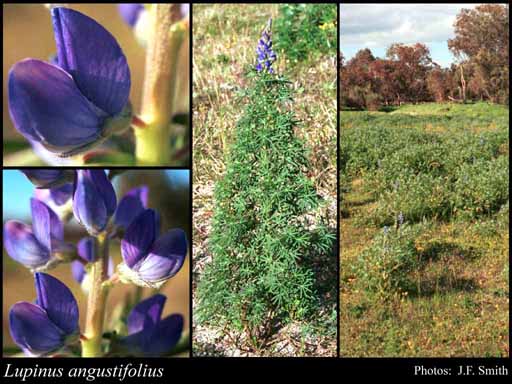- Reference
- Sp.Pl. [Linnaeus] 2:721 (1753)
- Conservation Code
- Not threatened
- Naturalised Status
- Alien to Western Australia
- Name Status
- Current
Erect, much-branched annual, herb, 0.2-1.5 m high. Fl. blue/white, Aug to Nov. Sand, loam, clay. Cultivated, occasionally naturalised in disturbed areas.







Scientific Description
Erect, herb. Stems terete, not spiny, hairy; pustules or glands absent. Leaves or phylloclades clearly present, compound, alternate, continuous with stem, 40-75 mm long, hairy, with simple hairs, flat with flat margins; margins entire; tubercles absent, leaflets 7-9, palmately arranged, terminal leaflet present, sessile; pustules or glands absent. Stipules present and persistent to older leaves, 5(-7) mm long, without glands, ribless. Pedicel present, 2-3 mm long, hairy. Bracteoles present and persistent. Calyx 7-8.5 mm long, not accrescent, hairy, with simple hairs, ribless; pustules or glands absent. Corolla 13-15.5 mm long, uniformly coloured, blue; claws present; standard 12.5-14 mm long, glabrous, not auriculate, wings 12 mm long, not auriculate, keel 11-13 mm long, beaked, not auriculate, glabrous. Stamens ten; anthers 2-2.2 mm long, at two different levels (filaments alternately long and short); filaments united in a closed sheath, 7-11.5 mm long. Ovary sessile or subsessile, hairy or glandular; style 14.7-15.5 mm long, hairy or glandular towards the base, not bearded, terete. Fruit dehiscent (a pod or follicle), 40-55 mm long, 13-15 mm wide, sessile or subsessile, constricted between the seeds, flat or compressed, hairy, with simple hairs, not beaked. Flowers in August, September, October and November. Occurs in the South-West Botanical Province, in the Geraldton Sandplains, Avon Wheatbelt, Jarrah Forest and Swan Coastal Plain IBRA regions.
Distribution
- IBRA Regions
- Avon Wheatbelt, Geraldton Sandplains, Jarrah Forest, Swan Coastal Plain.
- IBRA Subregions
- Dandaragan Plateau, Katanning, Lesueur Sandplain, Merredin, Northern Jarrah Forest, Perth, Southern Jarrah Forest.
- Local Government Areas (LGAs)
- Bunbury, Busselton, Carnamah, Chittering, Cockburn, Corrigin, Dardanup, Donnybrook-Balingup, Dowerin, Gingin, Harvey, Kalamunda, Melville, Mundaring, Murray, Nedlands, Northam, Perth, Plantagenet, Stirling, Swan, Three Springs.
Management Notes (for the Swan NRM Region)
Alternative Names. Australian Sweet Lupin.
General Biology. Growth form. Herb. Life form. Annual. Reproduction. Seed. Dispersal. Water, soil movement, planting for agriculture. Seedbank persistence. short-medium term.
Notes. Most varieties are poorly adapted to alkaline and calcareous soils. In a high rainfall season or location, seed set will be delayed considerably. Late season high temperatures can induce poor seed-set. Able to increase soil nitrogen due to compatable bacteria, which may aid establishment of other introduced plants. Has hard-coated impermeable seed.
Additional information. Origin. Mediterranean. History of use/introduction. Widely cultivated for seed (grain), animal feed. Similar exotic species. Lupinus cosentinii.
Suggested method of management and control. Hand remove scattered plants. Spray dense infestations with metsulfuron methyl 0.1 g/15 L (2-3 g/ha) + wetting agent or spot spray Lontrel® 6 ml/10 L (300 ml/ha) + wetting agent to late flowering, this will prevent seed set. Read the manufacturers' labels and material safety data sheets before using herbicides. For further information consult the Australian Pesticides and Veterinary Medicines Authority to determine the status of permits for your situation or state.
Management Calendar
| Calendar Type | Jan | Feb | Mar | Apr | May | Jun | Jul | Aug | Sep | Oct | Nov | Dec | Comments |
|---|---|---|---|---|---|---|---|---|---|---|---|---|---|
| Germination | Y | Y | Y | Y | |||||||||
| Active Growth | Y | Y | Y | Y | Y | Y | |||||||
| Flowering | Y | Y | Y | Y | Y | ||||||||
| Fruiting | Y | Y | |||||||||||
| Manual Removal | Y | Y | Y | Y | |||||||||
| Herbicide Treatment | Y | Y | Y | O |
Legend: Y = Yes, regularly, O = Occasionally, U = Uncertain, referred by others but not confirmed.
References
- Brand, J.D., Tang C. & Rathjen, A.J. (2002) Screening rough-seeded lupins (Lupinus pilosus Murr. and Lupinus atlanticus Glads.) for tolerance to calcareous soils. Plant and Soil, Volume, 245 (2): 261-275.
- Brand, J.D., Tang, C. & Rathjen, A.J. (1999) Adaptation of Lupinus angustifolius L. and L. pilosus Murr. to calcareous soils. Australian Journal of Agricultural Research, 50 (6): 1027 - 1034.
- Brown, K. & Brooks, K. (2002) Bushland Weeds: A Practical Guide to their Management. Environmental Weeds Action Network, Greenwood.
- Emms, J., Virtue, J.G., Preston, C.T. & Bellotti, W.D. (2005) Legumes in temperate Australia: A survey of naturalisation and impact in natural ecosystems. Biological Conservation, 125: 323-333.
- Hussey, B.M.J., Keighery, G.J., Dodd, J., Lloyd, S.G. & Cousens, R.D. (2007) Western Weeds. A guide to the weeds of Western Australia. 2nd Edition. The Plant Protection Society of Western Australia, Victoria Park.
- Liu, D.L., Luckett, D.J. & Scott, B.J. (2001) Sowing dates, phenology and yield in lupins (Lupinus angustifolius). In Science and Technology: Delivering Results for Agriculture? Proceedings of 10th Agronomy Conference 2001, Hobart, Tasmania. URL: http://www.regional.org.au/au/asa/2001/1/d/liu.htm#TopOfPage - Accessed May 2010.
- Moore, C.B. & Moore, J.H. (2002) Herbiguide, the pesticide expert on a disk. Herbiguide, PO Box 44 Albany, Western Australia, 6330.